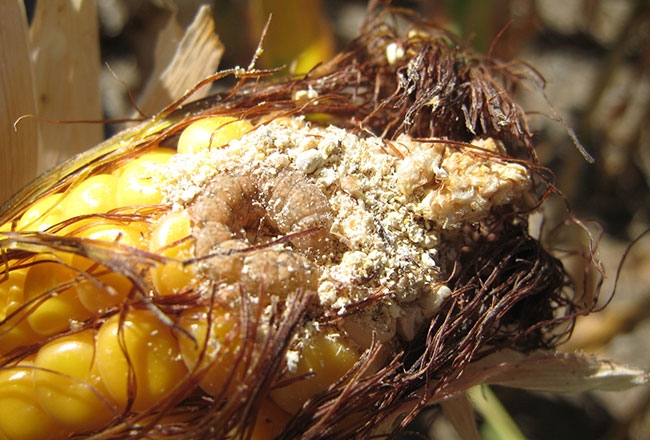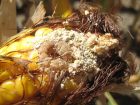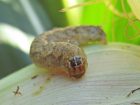
Features
Agronomy
Insect Pests
Advancements in controlling western bean cutworm
Figuring out how to fight a fairly new pest, like the western bean cutworm (WBC), is a bit like preparing to face off against a new sports opponent. “If you’re going to compete in a sport, the best thing to do is study your opponent’s strengths and weaknesses, and then try and play to their weaknesses,” says Jeremy McNeil, a biology professor at the University of Western Ontario.
March 21, 2018 By Carolyn King
 Western bean cutworm Figuring out how to fight a fairly new pest
Western bean cutworm Figuring out how to fight a fairly new pest“If you’re going to try and develop a rational pest management program, the first thing you have to do is really understand the organism you’re trying to manage.”
So, McNeil and his research group are working to fill some key gaps in our understanding of WBC reproductive and overwintering biology in Ontario.
“The WBC was originally limited to the Western United States. Then, from about the turn of the 2000s, it started moving eastward and came into the Great Lakes area,” he notes. Ontario researchers began monitoring for WBC in 2006 and caught their first specimen in 2008. Since then, the pest has been spreading in the province, now causing serious problems in corn and becoming a growing concern in dry beans.
“The Great Lakes area is very conducive to western bean cutworm, in comparison to Nebraska where most of the research has been done on this pest,” says Tracey Baute, field crop entomologist with the Ontario Ministry of Agriculture, Food and Rural Affairs (OMAFRA). “So [Ontario researchers] have had to reinvestigate certain aspects like management and thresholds and even some basic biology to better predict and understand what is going on here.”
The insect has a single generation per year. The adult moths begin emerging from the soil in mid-summer. The females lay their eggs on host plants soon after. The eggs hatch in a few days, and the larvae begin feeding on the plants. In the fall, the mature larvae drop to the ground and burrow into the soil. In this pre-pupal stage, they remain dormant until they pupate in the spring.
The moths prefer to lay eggs in corn from the late whorl to early tassel stage. If they can’t find corn at this stage, they’ll lay their eggs in dry beans.
The larvae feed on corn ears and dry bean seeds. In corn, the feeding damage causes direct yield losses, but more importantly it provides entry points for ear rot pathogens like Fusarium that can produce toxins. Similarly, in dry beans, the larvae cause direct yield loss, but quality loss, due to damaged seeds and increased pod disease, is a bigger concern.
Predictive ability of traps
One aspect of McNeil’s studies relates to WBC traps. These traps use lures based on the sex pheromones that female WBC moths emit to attract potential mates. The traps are used to track the presence of the moths so growers can identify at-risk fields and determine when to start scouting for eggs and larvae. However, the trap counts don’t predict the crop damage levels in Ontario.
“Normally, if you catch lots of moths, you would expect to see lots of damage,” McNeil says. “They were catching lots of moths [in Ontario traps] but there was no good correlation between the number of moths and any level of damage.”
To figure out what might be causing this oddity and perhaps to enhance the ability of trap counts to predict damage levels, McNeil and his research team have been investigating several elements of WBC reproductive biology.
For instance, they have been studying WBC pheromones. McNeil points out that the pheromone formulation currently used in WBC traps is based on a blend of pheromones extracted from just four female moths of unknown age and mating status in a 1983 study. So, one of McNeil’s graduate students, Joanna Konopka, analyzed the pheromone components in the glands of WBC females. Her results suggest further study of the pheromone blends actually emitted by females might result in a more effective lure.
Another example is a current study about why both female and male moths are found in the traps. “It’s a female sex pheromone, so normally you would expect only male moths,” McNeil notes. “There’s a number of possible reasons why both males and females are in the traps. For example, maybe both sexes respond to the pheromone, or maybe the males get caught and then they emit a pheromone that attracts females.” McNeil’s group is comparing traps baited with males and with females in a field experiment.
Overwintering survival
From McNeil’s perspective, the biggest WBC question is the relative importance of immigrant versus resident populations in Ontario. Answering that question could be helpful for predicting WBC populations in the province and for developing management strategies.
One part of finding the answer is to assess the insect’s overwintering success in Ontario. To this regard, McNeil and his group, are working with Brent Sinclair in Western’s biology department, to look into several factors affecting overwintering survival.
They have already completed a cold hardiness study with the pre-pupae. “We have shown that they do not freeze until they are at about -6 to -14 C,” he says. Whether the insect encounters such cold temperatures depends on factors like the insect’s burrowing depth, snow cover depth and air temperature.
McNeil adds, “Some people suggest that the insect’s expansion into the Great Lakes region has been the result of climate change. But the results from our cold hardiness studies seriously suggest that western bean cutworms could have survived here 20 years ago. In fact, I could possibly argue that recently our weather has gotten less favourable for them because we are getting very hot falls now and less snow cover than we used to.” With less snow cover, the soil is less insulated from the cold, and hot fall weather could lead to desiccation and other problems for the insect.
Basically, the insect needs to burrow deep enough that it isn’t harmed by extreme conditions like very cold or very hot weather, but not so deep that it uses most of its energy in digging down and doesn’t have enough left to survive until spring.
Kurtis Turnbull, another one of McNeil’s graduate students, is looking at WBC burrowing depth and how it is influenced by factors like soil type, temperature and humidity conditions, and how the depth relates to overwintering survival.
“[To do this experiment], we get big five-litre buckets, drill holes in the bottoms so the water can drain out, and put small pebbles in the bottoms. We place temperature probes at different depths in the buckets to track the temperature profile. Then we fill the buckets with different types of soils, about 60 centimetres (cm) deep.” They put the prepared buckets into holes in the ground early in the season so the soil will have time to settle and reach a density similar to that of normal field soils. Some buckets are planted with corn, and others are left with bare soil, to compare the effects of these two treatments on burrowing depths.
In addition, the research team collects egg masses in the field twice a year – earlier and later in the egg laying period. Then they rear these two groups of eggs in what is called an insectarium, under natural conditions of temperature, humidity and day length. When the larvae are ready to go into the soil, they are allowed to burrow into the soil in the buckets. Then in late September, November and March, the research team digs up subsamples of the early and late groups to determine the burrowing depths and survival rates.
McNeil and his team are seeing some interesting preliminary results from this study. For instance, most of the larvae are burrowing no deeper than about 30 centimetres.
Also, the overwintering mortality has been quite high so far. The hot fall conditions in 2016 and 2017 appear to be playing a big part in that. In 2016, some of the pre-pupae had already pupated in the fall when normally they would not pupate until the following spring. And in late September 2017, overall less than 20 per cent of the pre-pupae were still alive in the eight-bucket subsample that was dug up at that time.
McNeil adds, “We have demonstrated very clearly that when the insect goes into the soil in the fall, it forms this lovely little adobe hut, more or less. Does this little chamber protect them climatically in some way? If so, why are they dying?”
The findings from these overwintering studies could be used in developing a model to predict WBC’s overwintering survival in different parts of Ontario each year. The findings also might help in devising specific control strategies. McNeil gives an example, if a field has serious problems with overwintering WBC populations, then one possible management option might be to disk the soil down to about 25 cm early in the spring. That might kill many of the overwintering insects and bring others to the soil surface where predators like beetles and birds could eat them.
Migrant populations
According to McNeil, a significant proportion of the WBC moths in Ontario are likely migrants from the United States. One of the indicators his group has looked at is how soon after emergence the moths are ready to mate. In moth species, resident moths are usually ready to mate as soon as they emerge from their pupae, whereas migrating moths generally have a delay of several days or more before they can mate, giving them time to get to their new home. Konopka studied the age at which virgin WBC females emitted sex pheromones for the first time under various conditions. All females had a pre-reproductive period of several days, suggesting that the WBC is a migrant species. Thus, it is possible that the majority of the moths captured in Ontario each summer are immigrants, although a certain proportion may be local.
McNeil is hoping to start a new study to determine what percentage of the population is migrating into the province and where the migrants are coming from. If the migrant populations always come from the same general area every year, then researchers could develop models to predict immigrating populations based on the conditions in that source region. However, if the migrants come from a huge area and from different regions from one year to another, then predicting migrating populations would be pretty tough.
His proposed study, in collaboration with Keith Hobson at the University of Western Ontario, aims to examine stable isotopes in the moth wings. “The stable isotope profiles in rainfall and groundwater vary on a north-south axis, and the stable isotopes in the insect’s diet as a caterpillar are what it will have as stable isotopes in its wings as a moth,” McNeil explains. Using the hydrogen isotopes in the wings, the researchers could determine if the insects were local or from farther south. As well, the carbon isotopes in the wings could show whether the caterpillars were feeding on dry beans or corn, another useful piece of information.
The results from all these WBC studies will help inform strategies for managing the pest in Ontario. This research is funded through the Ontario Bean Growers and Grain Farmers of Ontario, as well as Growing Forward 2, a federal-provincial-territorial initiative. The Agricultural Adaptation Council assists in the delivery of Growing Forward 2 in Ontario.
Dry bean risk factors
Other Ontario researchers have also been working on WBC. “Jocelyn Smith and Art Schaafsma at the University of Guelph’s Ridgetown Campus have really focused on understanding more about the pest in corn and getting a handle on management and vomitoxin concerns. They are going to continue that work,” Baute says. “[Chris Gillard at Ridgetown Campus] had a grad student some years ago who looked at western bean cutworm in dry beans, but the pest wasn’t very prevalent in dry beans in Ontario at that time.”
Now that WBC has become more established in Ontario dry beans, Baute is collaborating on a new dry bean project with Gillard, Jim Barclay at the Hensall District Co-operative, and Meghan Moran, who is OMAFRA’s canola and edible bean specialist.
“We want to get a better handle on when and what conditions might make a dry bean field more attractive to the moth than the neighbouring cornfield,” Baute says. “We want to see if there are any other elements [in addition to crop stage] that could help us predict if a specific bean field is going to be at risk.”
Predicting which dry bean fields are at risk is especially important because it’s almost impossible to scout for WBC eggs and larvae in this crop. The moths lay their eggs on the underside of the bean leaves deep in the canopy, and the larvae mainly live in the soil during the day and feed at night. Scouting in corn is much simpler because the moths lay their eggs on the upper side of corn leaves near the top of the plant, and the larvae feed during the day.
In 2017, Baute and the other researchers chose several sites where a corn field and a dry bean field were adjacent to each other. She says, “We set up traps in each of the fields, and we looked diligently for eggs and used sweep nets [for moths] in the dry beans. And we tracked features like crop stage and all the other elements that we think may potentially play a role.”
This was just a preliminary look at the issue, but they hope to continue this study in 2018 and perhaps get a grad student to work on it.
Baute emphasizes that WBC is a widespread and growing problem in Ontario, so growers need to be looking everywhere for this pest. “Originally, we were focused on the hotspot regions, the sandy soils around Bothwell and around Tillsonburg. But growers need to lose the idea that it’s only a Bothwell and Tillsonburg issue. Enough moths have been spreading out across the province that we are starting to reach a critical mass, where enough larvae are going into the soil in Ontario. [So, if overwintering conditions allow most of those insects to survive, then the pest could become] much more established farther and farther east and north. Monitoring the moths with traps and gauging your crop’s stage at peak flight are really key to staying ahead of this pest.”
For more information on WBC trapping, scouting and management, see the WBC corn and dry bean factsheets available at fieldcropnews.com.

